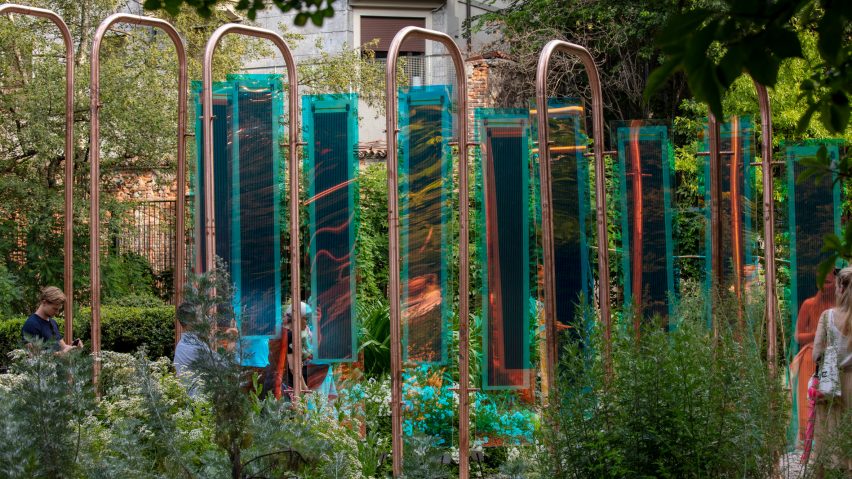Italian studio Carlo Ratti Associati and architect Italo Rota have used over 500 metres of copper pipe to create energy-generating sculptures for its Feeling the Energy installation in the Brera botanical garden at Milan design week.
The installation was designed as a path through the small park that lets people explore different types of sustainable and renewable energy.
The copper pipes were bent to create arches and sculptures that support solar and kinetic energy generation devices. This turns the botanical garden in central Milan into an "energy park".
The electricity that is generated is stored with the help of a network of small batteries and used to illuminate the garden at night.
Architect Carlo Ratti, who created the design together with Rota, aimed to showcase what a self-sufficient energy infrastructure could look like, with different sculptures working in different ways.
"'Feeling the Energy is an energy park that explores both energy production and consumption," Ratti told Dezeen.
"When it comes to the former, we display several forms of solar power – organic photovoltaic (OPV) and luminescent solar concentrators (LSCs) – as well as several forms of kinetic power; you can move a carousel or turn a handle to produce light."
The installation also showcases more abstract ways to create energy.
"From a more conceptual point of view, you can experience music and sound vibrations (those produced when you play a vibraphone) as other, unexpected ways to 'feel the energy'," he added.
The installation comprises six sculptures in total, called Energy Carousel, Garden Orchestra, The Leading Logo, Powering Vibrations, Blinds in the Sun and Solar Garden.
As well as powering the lights in the evening, some of the installations are also used to cool the botanical garden down by the use of evaporative cooling, using water vaporizers that are activated by sensors to mist the paths when people walk past them.
Ratti, who is the founding partner at Carlo Ratti Associati and the director of the MIT Senseable City Lab, said the design is intended to work as a test case.
"The installation aims to test cutting-edge energy technologies (in particular those related to PVs) in an urban environment," he said.
"The Orto Botanico can be considered as a small 'living lab,'" he added. "It showcases a miniature model of a self-sufficient energy system, inviting visitors to discover the functioning of this system as well as to improve its efficiency. In this sense, it connects each of us with the design of energy grid systems."
He also hopes that the installation will inspire people to think about how we can recover the energy that we create in our daily life.
"There is also an educational component," Ratti said. "Along the exhibition path, you can find some technical devices whose specific purpose is to harvest energy, like the LSC panels. But even more importantly, you can get a sense of how objects from our daily life can potentially become tools to produce energy."
The installation was created for Plenitude, a branch of power company Eni that functions as the "outpost" for its decarbonisation strategy.
For last year's Milan design week, Ratti worked with the brand to look at how plants capture carbon. He defended the choice to work with Eni, a fossil-fuel company, by saying it is "serious about their carbon transition process". The company has pledged to be carbon-neutral by 2050.
Ratti recently designed an Italian house around a 10-metre-tall tree.
The photography is by Marco Beck Peccoz.
Feeling the Energy is on show in Orto Botanico, Brera, from 6 to 13 June as part of Milan design week 2022, which takes place from 6 to 12 June 2022. See our Milan design week 2022 guide on Dezeen Events Guide for information about the many other exhibitions, installations and talks taking place throughout the week.
Dezeen is on WeChat!
Click here to read the Chinese version of this article on Dezeen's official WeChat account, where we publish daily architecture and design news and projects in Simplified Chinese.

